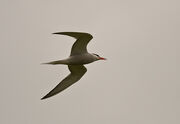The Common Tern (Sterna hirundo) is a seabird of the tern family Sternidae. This bird has a circumpolar distribution breeding in temperate and sub-Arctic regions of Europe, Asia and east and central North America. It is strongly migratory, wintering in coastal tropical and subtropical regions.

Common Tern - http://www.flickr.com/photos/gordiesbirdies/
Description[]
This medium-sized tern is 34-37 cm long with a 70-80 cm wingspan. It is most readily confused within its range with the similar Arctic Tern and Roseate Tern.
Its thin, sharp bill is red with a dark tip. Its longish legs are also red. Its upperwings show a dark primary wedge, unlike the Arctic Tern, in which they are uniformly grey. Its long tail extends only to the wingtips on the standing bird, unlike Arctic and Roseate Terns, which extend past the wingtips. It is not as pale as the Roseate Tern and has longer wings.
In winter, the forehead and underparts are white. Juvenile Common Terns show extensive ginger coloration and lack the 'scaly' appearance of juvenile Roseate Terns.
The call is a clear piping, like that of the Arctic Tern, but lower-pitched and less strident.
Behaviour[]
Food and feeding[]
The Common Tern feeds by plunge-diving for fish, from either the sea or freshwater lakes and large rivers. It usually dives directly.
Breeding[]
This species breeds in colonies on coasts and islands and often inland on suitable freshwater lakes. This latter practice is assisted by the provision of floating "tern rafts" to give a safe breeding area. It lays two to four eggs. Like many white terns, it is very defensive of its nest and young and will attack humans and other large predators. The offering of fish by the male to the female is part of the courtship display.

